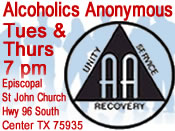SFA University
January 4, 2021 - Stephen F. Austin State University has named a new vice president for student affairs.
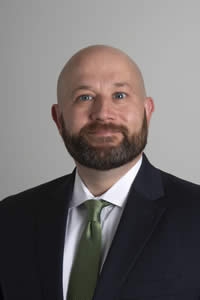 Dr. Brandon Frye, who currently serves as associate vice president for academic engagement and student affairs at the University of West Florida, will join the SFA staff on Feb. 4 and will lead the student affairs division, which comprises student programs and services, including housing, student engagement, counseling and wellness.
Dr. Brandon Frye, who currently serves as associate vice president for academic engagement and student affairs at the University of West Florida, will join the SFA staff on Feb. 4 and will lead the student affairs division, which comprises student programs and services, including housing, student engagement, counseling and wellness.
After conducting a national search for the position, Dr. Scott Gordon, SFA president, said Frye’s 20 years of student affairs experience will be essential in advancing SFA’s mission and supporting student engagement, health, wellness and retention.
“Dr. Frye will serve as an advocate for students,” Gordon said. “He will be charged with developing and facilitating high-quality programs and services and effective business practices that support student learning and post-college success.”
Frye will provide direct leadership for departments across campus that are designed to attract potential students, enhance student development, promote retention and enrich the educational experience for all students.
The hire comes at a pivotal moment in SFA’s history, Gordon said, as the university prepares to celebrate its 100th anniversary while strategically managing the currently disruptive higher education environment.
“The work ahead will require a strategic framework for student success and community engagement that provides a fully integrated student experience,” Gordon said. “We look forward to collaborating with Dr. Frye and the student affairs team in providing transformational experiences that support, engage and empower students to succeed.”
At the University of West Florida, Frye also serves as dean of students and deputy Title IX coordinator and manages a $14.5 million budget. In 2019, he played an executive-level role in developing UWF’s Division of Academic Engagement and Student Affairs and also provided leadership for $2.1 million in construction and enhancement projects for the University Commons facility.
Frye provided leadership in developing and implementing the university’s COVID-19 response and return-to-campus plan for students. Additionally, he serves as an affiliate instructor for the Master of Education program in College Student Affairs Administration.
Previously, Frye provided institutional leadership in areas including student development, crisis response, diversity programming and student conduct at Auburn University from 2010 through 2013 and aided in student success and engagement efforts while working in student conduct and fraternity and sorority life programs at the University of Georgia from 2001 until 2010.
In addition to serving as vice president of the board of directors for Pike University, the leadership and educational curriculum foundation for the Pi Kappa Alpha international fraternity, Frye is the university delegate for the National Association of Student Personnel Administrators.
Frye said he was drawn to SFA because of its strategic plan and focus on creating transformational student experiences.
“I am excited about joining the Stephen F. Austin team, and I look forward to working collaboratively with faculty, staff, students, and community stakeholders to enhance student development, engagement, well-being, belonging, success, and post-college employment,” he said. “Dr. Gordon’s values, passion, and commitment to student success aligned well with my educational philosophy and vision for student affairs.”
Frye received his doctorate in student affairs administration from the University of Georgia, as well as a master’s degree in student development and a bachelor’s degree in history and secondary education from Appalachian State University. He participated in an educational management symposium at Harvard University in 2019.
Frye will replace Dr. Steve Westbrook, who retired from SFA in December 2020.
December 23, 2020 - Despite the challenges of 2020, many community members have stepped up through various acts of service to help their family, friends and neighbors. In order to help better meet the needs of individuals near and far, Stephen F. Austin State University’s Office of Multicultural Affairs is encouraging students to participate in its MLK Day of Service in Nacogdoches or virtually in their local communities.
“Due to social distancing regulations, we want to provide virtual students with a way to still participate in this important day,” said Star Jackson, OMA student ambassador. “Even though we can’t all be together, it is heartwarming to know Lumberjacks all over will be serving their community in a special way.”
Locally, OMA has partnered with 16 different agencies to complete projects, including SFA’s The Pantry and Appleby Community Farm, Keep Nacogdoches Beautiful, Nacogdoches Master Gardener’s Demonstration Garden and Millard’s Crossing Historic Village. Students also will complete projects for individual Nacogdoches residents.
The annual event will take place Jan. 18, 2021. Check-in will begin at 8:30am. Dr. Kofi Smith, president and CEO of Atlanta Airlines Terminal Company, will deliver the keynote speech at 9am Students who participate in the MLK Day of Service in Nacogdoches will receive a free lunch, and T-shirts will be provided to all volunteers who complete their assigned projects.
Nacogdoches community members are encouraged to submit project proposals by Jan. 8. Past projects have included painting, landscaping and cleaning. Projects will be assigned to students on the day of the event.
The OMA also is inviting SFA faculty and staff and Nacogdoches community members to serve as site mentors who will work alongside students to complete projects. Site mentors are encouraged to share leadership advice and help educate students about the community. They can sign up to volunteer through Jan. 7 online at sfasu.edu/oma.
MLK Day of Service was initiated to honor the acts of service by the late civil rights activist Dr. Martin Luther King Jr. In 1994, MLK Day was designated as a national day of service and is sponsored by the Corporation for National and Community Service and the Martin Luther King Jr. Center for Nonviolent Social Change.
“This day is not a day of selfishness, but of selflessness,” Jackson said. “There is truly an opportunity for every member of the community to be involved.”
For more information, contact the Office of Multicultural Affairs at oma@sfasu.edu, or visit sfasu.edu/oma.
December 11, 2020 - The school psychology program at Stephen F. Austin State University has received a nearly $15,000 grant from the Texas Woman’s University Woodcock Institute to research why children with attention deficit hyperactivity disorder lose focus specifically during searching activities like a game requiring them to spot missing objects.
“Thank you for allowing us to support your important line of research,” said Dr. David C. Miller, executive director of the research institute, in SFA’s notification letter.
SFA researchers want to determine if eye-tracking technology can differentiate between the reasons why children with ADHD demonstrate attentional deficits during aspects of stimulus processing, such as search, according Dr. Luis Aguerrevere, associate professor and director of the Human Neuroscience Laboratory in the Department of Human Services and Educational Leadership at SFA.
“Specifically, we will test the idea that greater deficits in eye regulation during a game called Spot the Missing Object will correlate with greater ADHD symptomatology,” Aguerrevere said.
Aguerrevere and Dr. Jaime Flowers, an assistant professor of school psychology at SFA, will conduct the research, which has wider implications for determining objective and valid assessments for children with ADHD.
“This research will help streamline the assessment process for ADHD in both schools and clinical settings, saving valuable resources,” Flowers said.
Aguerrevere and Flowers will begin collecting data in January. They hope to recruit 100 children ranging in age from 8 to 11 years old who are in the process of obtaining a comprehensive assessment for ADHD.
“While these children play Spot the Missing Object, we will measure time, accuracy and eye-tracking variables,” Flowers said. “Hopefully, this data will validate the hypothesis that children with ADHD perform differently during the game, which has the potential to become a reliable and valid screener for ADHD.”
The Woodcock Institute awards grants to institutions conducting research that aligns with its mission: the advancement of neurocognitive research and translation of neurocognitive research into practice.
For more information, email Flowers at jaime.flowers@sfasu.edu.
December 8, 2020 - For top graduates from the Stephen F. Austin State University Rusche College of Business, the landing spot of Lufkin is increasingly becoming an option. And while the nightlife and the food scene might not compare to what a young professional would find in Houston or Dallas, the opportunity surely does.
Located on Lufkin’s west loop, one of Angelina County’s largest employers, Lockheed Martin, offers great pay, meaningful work, top-tier benefits, and the chance to be part of one of the largest companies in the world. The international aerospace, defense, arms, security, and advanced technologies company employs 110,000 people globally, and had nearly $60 billion in net sales last year.
The Lufkin facility recently expanded with a 30,000-square-foot building and plans to add more than 100 jobs during the next few years. While Lockheed has been a fixture at SFA career fairs since 2017 – it most recently participated in the Fall Career and Internship Expo in October – and while it’s been known as a destination for engineers, a handful of business alums have joined the company since 2018. It’s a new yet positive trend, one that Dr. Pam Rogers, a professor in the department of Management and Marketing, wants to nurture.
The college, Rogers said, can customize a degree plan with courses that dovetail nicely with a career in advanced manufacturing such as: Operations, Purchasing, Analytics, Supply Chain Management, Project Management, and other electives. For those who take that path, or something similar to it, employment at a place like Lockheed could be the reward.
“They are now looking to the Rusche College of Business for talent – not just engineering students, but business students,” Rogers said. “It’s obvious they’d want the engineering students, but the business students aren’t that obvious.”
Trevor Crittenden was one such student. He enrolled at SFA when he was 25 years old. He was behind with his degree, his career, and even his life. Or so he thought.
That was in fall 2017, after he’d convinced himself to break out of a dead-end job in Longview and reclaim his ambition with an all-in move to Nacogdoches. The goal was simple – take a lot of courses in a short amount of time and get himself back in the game.
He did just that. In two years – with the help of completed prerequisites and a 15-hour summer semester – Crittenden earned his degree in general business and landed a job as a manufacturing planner with Lockheed. In the parlance of operations management, his journey could be described as inputs, transformation, and outputs.
Nowadays, Crittenden, 28, doesn’t think of himself as being behind. And having met his fiancé, Brooke, at the Lufkin location, he considers himself right on time, or even a bit ahead of the pack.
"I needed to dedicate two years of my life for the rest of my life,” he said. “I looked at all the things I could possibly do, and in business there are no limits. The more I put in, the more I’ll get out.”
While Crittenden was in high school, he was in a serious motorcycle accident that left him with major back problems that ultimately derailed his first attempt at a degree in nursing. A series of surgeries, the last of which was successful, left him unable to finish the program, hence the associate degree and a job as a cardiac stress technician in Longview. But even if he had found his health, Crittenden knew there was something bigger out there.
“There wasn’t any growth,” Crittenden said. “I couldn’t move up because I didn’t have a bachelor’s degree.”
And then came SFA and Rusche’s faculty and staff.
"I found my home,” he said. “They would do whatever was in their power to help me succeed.”
Crittenden wrapped up his two-year push through business school with a 3.9 GPA and went to work two days after he graduated in May 2019. For now, Lufkin is a good spot. But Lockheed has a headquarters in Grand Prairie for missiles and fire control, the division in which he currently works. Lockheed also has a facility in Fort Worth.
“I think that’s my end goal,” Crittenden said, referencing a future move to the DFW metroplex.
Dr. Tim Bisping, dean of the business college, sees a long-term, fruitful connection developing between business majors and the blue-chip company that’s employing them: Alums have a quality place to begin their careers while Lockheed can rely on them to do the job they’re hired to do.
“Graduates of the Rusche College of Business are prepared to have an immediate impact on business operations,” Bisping said. “This continuing relationship with Lockheed Martin serves as validation of this, and it represents an outstanding opportunity for both our graduates and the company.”
As Crittenden raced to make up for lost time, a younger classmate of his was busy executing the perfect plan.
Kelsey Bowers Massey knew going into college that she wanted a career in manufacturing, so a degree in business management was the only thing on her academic radar. As a Lufkin native, she was also aware of Lockheed and the opportunities it offered. Between existing Lufkin connections and those she knew she could make at the business college, a place like Lockheed looked like it was well within reach.
“I was one of those students who was anxious to get done and jump into the business world,” Massey said.
If that was her goal, she accomplished it. She was hired as a manufacturing planner four months prior to graduation, starting two days after college was over in December 2019.
But just because she was career-oriented from the beginning didn’t mean she blazed through college without enjoying the experience. She cherishes the hands-on, face-to-face time she had with professors, particularly Rogers and Dr. Matt Lindsey, her advisor.
During her senior year, Massey was also president of the SFA chapter of Delta Delta Delta, one of the largest and oldest sororities in the United States. With about 130 members at SFA, and not to mention the chapter’s finances and its 30-plus officers, Massey had her hands full.
“I learned how a business works,” she said. “It prepared me for a real job. You see everything.”
As a 23-year-old woman looking to make her way in the business world, Massey has a great role model right there at Lockheed. Marillyn A. Hewson, now the executive chairman of the company, was the chairman, president and CEO from January 2014 to June 2020. In 2018, Hewson, who has a bachelor’s in business administration and a master’s in economics, was considered by Forbes to be one of the most powerful women in the world.
“I was pleasantly surprised at how many women work at the Lufkin location,” Massey said. “Having a female CEO has changed the culture at Lockheed Martin.”
Massey is certainly ambitious. In the near future, she plans on returning to school for an MBA, which puts her on the long track for upper management. And since Lockheed has locations in every state and in countries across the world, Lufkin might not be her ultimate destination.
“I’ll never turn down an opportunity,” she said.
Even if she winds up in a major metro with a plumb position and a salary to match, the alma mater will never be far from her thoughts.
“I want to be part of the SFA community,” Massey said.
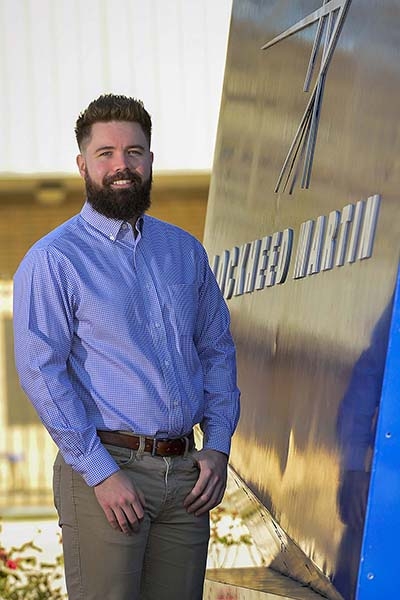
After his plan for a career in nursing fell through, Trevor Crittenden rebounded with a business degree from Stephen F. Austin State University. He went to work at Lockheed Martin two days after he graduated in May 2019.
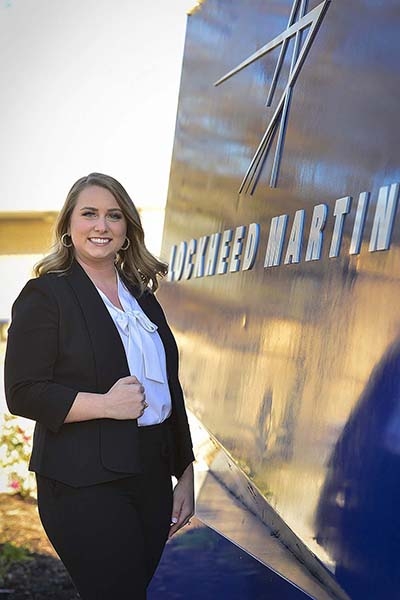
Kelsey Bowers Massey always had her eye on a career in manufacturing. She went to work for Lockheed Martin two days after she graduated from Stephen F. Austin State University in December 2019.
December 8, 2020 - For the first time in almost one year, students at Stephen F. Austin State University will be honored for their academic achievements during commencement ceremonies in Johnson Coliseum. To make this possible in a safe manner, the university will host its first-ever slate of five commencement ceremonies – two on Dec. 11 and three on Dec. 12.
To accommodate both physical distancing mandated by COVID-19 concerns and the construction project currently underway at the coliseum, each graduate has been allotted six tickets to provide to their guests.
“We and our students were heartbroken when we had to cancel the May and August ceremonies, so we have been planning for and looking forward to this ceremony for months,” said Dr. Scott Gordon, SFA president. “Although the coliseum aesthetics may not be ideal at this time, our safety officers have confirmed that the facility provides adequate access for our guests, even those with accessibility needs.”
Gordon will serve as commencement speaker for each ceremony. The president of SFA since August 2019, Gordon is a native of Malone, New York, and earned his bachelor’s degree in biology from the State University of New York at Cortland. His master’s degree and doctorate in botany and mycology are from the University of Tennessee in Knoxville.
Previously, Gordon served as Eastern Washington University’s provost and as a dean of the Pott College of Science, Engineering and Education at the University of Southern Indiana.
On Friday, the 3 p.m. ceremony will recognize candidates from the Arthur Temple College of Forestry and Agriculture, as well as graduates from May and August who requested to participate in the ceremony.
The 6 p.m. ceremony will recognize candidates from the College of Fine Arts and the College of Liberal and Applied Arts.
At 9 a.m. Saturday, Dec. 12, candidates from the Rusche College of Business and the Department of Human Services and Educational Leadership will be recognized.
The noon ceremony will recognize candidates from the Department of Education Studies and the School of Human Sciences.
Candidates from the College of Sciences and Mathematics and the Department of Kinesiology and Health Science will participate in a 3 p.m. ceremony.
Degrees to be awarded include 968 bachelor’s, 122 master’s and three doctoral degrees. More than 275 students will graduate with honors, including 116 cum laude, 78 magna cum laude and 77 summa cum laude. Forty-two will graduate with the university scholar designation.
Children under age 5 do not need a ticket to attend the ceremony. Graduates can reserve guest tickets by completing the commencement registration form emailed to them.
To view the ceremony online, visit facebook.com/sfasu. An account is not required to watch the livestream.
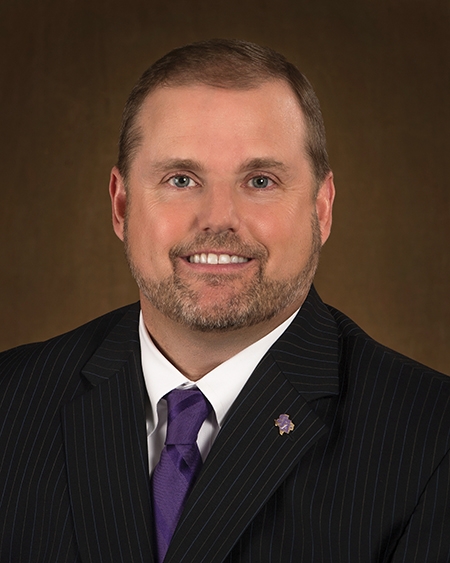
Dr. Scott Gordon, president of Stephen F. Austin State University, will be commencement speaker for the university’s December ceremonies, which will be held in-person in Johnson Coliseum Dec. 11 and 12.
December 4, 2020 - Research conducted by Stephen F. Austin State University environmental science graduate student Kimberly Gamez is adding to a growing body of work with the goal of alleviating the ever-increasing demand on one of Texas’ most precious natural resources — water.
According to the Texas Water Development Board, Texas’ population is expected to increase by more than 70 percent during the next 50 years. Accompanying this growth is increased demand on the state’s already strained water resources.
“While water does recirculate through the hydrologic cycle, the amount available that is clean enough to drink is limited,” Gamez said. “So, anything we can do to conserve it is important.”
According to the U.S. Bureau of Reclamation, although water covers 71 percent of the Earth’s surface, only 0.5 percent is available, fresh water.
Gamez said when she began researching graduate programs, she sought a professor actively looking for solutions to water supply and quality issues. This led her to Dr. Matthew McBroom, associate dean of SFA’s Arthur Temple College of Forestry and Agriculture and T.L.L. Temple professor of forestry. McBroom’s career as a hydrologist spans more than two decades, and his ongoing exploration of roof-harvested rainwater to help alleviate the demand on water resources and reduce storm water runoff piqued Gamez’s interest.
Gamez explained that while East Texas has more forest coverage than other regions of the state where rainwater harvesting is more popular, such as Central Texas, there is a nationwide push to plant more trees in residential and urban areas across the U.S. Additionally, awareness of the benefits of rainwater harvesting is increasing — even in seemingly water-rich regions such as East Texas.
“If both trees and roof harvesting of rainwater are to have a significant place in the future, the interaction between the two needs to be analyzed and quantified,” Gamez said. “Effective planning and design of collection and filtration systems for rainwater harvesting requires understanding the factors that affect harvested rainwater quality.”
Thanks to East Texas’ ample forest cover, Gamez didn’t have to look far to find the perfect study site.
Gamez installed nine metal roofs with rainwater catchment systems at the Todd Agricultural Research Center to evaluate the effects of pine and hardwood canopy cover versus no tree cover on roof-harvested rainwater quality during a period of one year. Her analysis compared these samples against Texas’ current drinking water standards.
“My end goal is to see how this could enhance Texas’ drinking water supply,” Gamez said. “You’re not going to get much better than drinking water standards.”
McBroom explained that in addition to wildlife associated with tree cover, which can introduce bacteria, the tannins and other natural-occurring phytochemicals present in leaves can alter the pH of the water, causing different reactions with roofing materials. These tannins also may alter the color of the water, which might reduce the efficacy of ultraviolet filters used to disinfect rainwater harvested for potable use. Tree canopies also collect a significant amount of dust and other airborne particulates that wash off the leaves, onto the roof and into the collection tank with the onset of rainfall.
Gamez’s results indicate that none of the water collected consistently met drinking water standards. Additionally, tree overhang resulted in lower pH with higher color, as well as higher total coliform bacteria, E. coli bacteria and turbidity, which is the measure of a liquid’s clarity.
“While the changes of the season did bring certain analyte levels closer to compliance with drinking water quality standards, only color and turbidity were decreased to acceptable levels,” Gamez said.
E. coli levels in rainwater harvested under hardwood trees also were found to be significantly higher than those in rainwater harvested under pine trees.
Gamez and McBroom said this difference in bacteria levels could be the result of a number of factors, such as the buildup of organic matter on roofs located under the tree canopies.
“Overall, for water quality, the open roof system is best, but it’s not worth cutting down a tree,” Gamez said. “Approximately 95 percent of roof-harvested potable systems in Texas have a disinfectant system in addition to filtration.”
Gamez also found that diverting the first tenth-of-an-inch of rainfall out of the storage tank at the beginning of the storm, called first-flush diversion, significantly reduces the contaminant levels.
“These first-flush diverters were found to be a low-cost technology that allows the rain to wash the tree canopies and roofs before storing the cleaner water in the tanks,” McBroom said.
While rainwater harvesting systems for indoor and potable use do require a filtration and disinfection system, untreated rainwater can be effectively used for agricultural uses, irrigation, outdoor water features, flushing toilets, or any number of activities that don’t require treated water — especially if a first-flush diverter is used.
“Here in Nacogdoches, the average 2,000-square-foot home would generate almost enough water on an average year for a family of four,” McBroom said. “So, homeowners have access to free water. The other beautiful thing about the state of Texas is that roof-harvested rainwater is 100-percent property of the landowner.”
In fact, the state government, as well as municipalities and counties across Texas, have implemented a number of incentives to promote the adoption of rainwater harvesting. For example, rainwater harvesting equipment and supplies are exempt from state sales tax, homeowner’s associations cannot prohibit rainwater harvesting systems, and many local governments offer rebates and incentives to residents who install these systems.
“There’s essentially no reason for homeowners not to take advantage of that resource,” McBroom said. “Even if they’re not going to use it for drinking, they can use it for lawn irrigation and so forth. That’s a great opportunity to capitalize on a resource that comes every time it rains.”
Throughout her research, Gamez personally saw interest in rainwater harvesting grow among local homeowners.
“This was one of the first studies I have been a part of where the public was excited about it,” Gamez said. “I would be purchasing supplies, and people would ask me what I was working on, and they would actually thank me for conducting this research.”
To learn more about rainwater harvesting system components and best practices, consult the Texas Water Development Board’s “Texas Manual on Rainwater Harvesting” or the Environmental Protection Agency’s “Rainwater Harvesting: Conservation, Credit, Codes, and Cost Literature Review and Case Studies.”
For information on past rainwater harvesting research conducted at SFA, contact McBroom at mcbroommatth@sfasu.edu or (936) 468-3301.
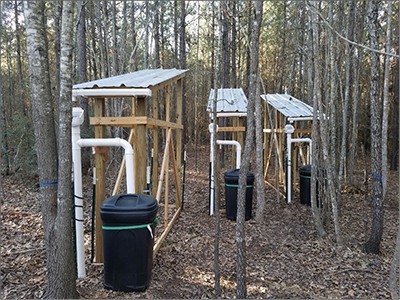
Research conducted by Stephen F. Austin State University environmental science graduate student Kimberly Gamez evaluated the effects of pine and hardwood canopy cover versus no tree cover on roof-harvested rainwater. Her results indicate that although tree canopy coverage does affect water quality, including total bacteria present, it does not pose a hindrance to the practice of rainwater harvesting. While roof-harvested rainwater used for indoor and potable use requires filtration and disinfection, untreated rainwater can be used for irrigation, outdoor water features and flushing toilets — all of which help conserve Texas’ water resources.
December 1, 2020 — What do Stephen F. Austin State University Lumberjacks, campus landmarks, squirrels and six children have in common? The answer is “A Day at SFA,” a new SFA Press publication geared toward children that encourages them to start considering the university as their future alma mater.
Written by University Marketing Communication staff members and alumnae Dr. Shirley Luna and Donna Parish and illustrated by 2019 alumnus Tristan Brewster, the book is filled with information about what makes SFA a special place — from its traditions to its iconic buildings.
“The book is for children, but it also appeals to alumni, students, faculty and staff and all university stakeholders,” said Kimberly Verhines, SFA Press director. “Because Tristan has incorporated so much of what makes SFA unique in his whimsical artwork, the book evokes wonderful memories from anyone associated with SFA.”
Starting at the Baker Pattillo Student Center, a group of six children are led on a tour around the campus by an SFA student tour guide dressed as a Lumberjack, who points out various landmarks and introduces the children to life on campus.
“From the historic Austin Building, which was completed in 1924 and houses the university president’s office, to SFA’s newest facility, the Cole STEM Building, with its 52-foot domed planetarium, young readers learn about 33 SFA-related landmarks,” said Dr. Shirley Luna, co-author and executive director of University Marketing Communications.
Almost every page also includes illustrations of longtime employees and many SFA leaders, including Dr. Scott Gordon, current president, and the late Dr. Baker Pattillo, former university president, with an index identifying the page number and the person(s) depicted.
“With the university soon approaching its 100th anniversary, the book will make a wonderful keepsake,” said Donna Parish, co-author and assistant director of creative services for University Marketing Communications. “It also would make a great Christmas gift for anyone who loves SFA.”
“A Day at SFA” is available for purchase online at sfasu.edu/kidsbook for $20 plus tax and shipping. Copies also can be purchased with cash, check and credit card in person at the Pearman Alumni Center, located at 300 Vista Drive. A portion of the proceeds benefit scholarships and student programming.
Dr. Shirley Luna, left, executive director of University Marketing Communications at Stephen F. Austin State University, and Donna Parish, assistant director, hold “A Day at SFA,” a new book they co-authored. The book, published by the SFA Press, takes young readers on a tour of the university’s campus and all things Lumberjack. It is available for purchase online at sfasu.edu/kidsbook or at the alumni office located on Vista Drive.
November 24, 2020 - Nacogdoches Helping Other People Eat food pantry is expanding thanks to a grant that involves a collaboration with three Stephen F. Austin State University schools.
Nacogdoches HOPE is using the funding from a large fiscal year 2021 Infrastructure and Capacity Building Challenge grant awarded by the East Texas Food Bank to purchase a building and property next to the food pantry and Jo’s Diner soup kitchen at 2100 E. Main St. This will help increase the number of individuals who can be served and food distribution, expand services and improve efficiency.
“With this expansion, we’ll be able to better connect clients with needed resources and services,” said Dr. Sharon Ninness, director of the expansion project, grant writer and Nacogdoches HOPE board member. “We look forward to broadening our collaboration with SFA as part of this project.”
Students from SFA’s DeWitt School of Nursing in the College of Sciences and Mathematics, School of Human Sciences in the James I. Perkins College of Education and School of Social Work in the College of Liberal and Applied Arts will gain valuable experience while serving the community, according to Wilma Cordova, professor of social work at SFA and volunteer coordinator for Nacogdoches HOPE.
“It is very common for schools of social work to have resource centers to connect clients to transportation, medical, mental health counseling, employment and child care services,” Cordova said. “To finally have a place to provide direct community support and a training location for our students is an ideal collaboration for the neighborhood, which is located in what the 2020 U.S. Census designated as the tract with the highest level of poverty in East Texas. Establishing this resource at the food pantry is key to helping achieve a healthier community.”
Students from SFA’s School of Social Work have interned at Nacogdoches HOPE during the past year to help with the 144% increase in demand for services since November 2019, according to Cordova.
The new building will have offices for social work interns to provide information and referral services to those in need; for human sciences interns in SFA’s food and nutrition program to provide clients with dietary consultations; and for nursing students and faculty members to conduct wellness checks for individuals who request them.
“This opens up new opportunities for our nursing students to learn and to provide care within the community,” said Michelle Klein, clinical instructor in the School of Nursing. “We are excited to collaborate with SFA’s School of Social Work and School of Human Sciences to improve the health and wellness of so many through Nacogdoches HOPE.”
In addition to food storage, meal preparation and computers clients can use to research healthy recipes and nutrition information, the building will house classes for the Cooking Matters program, a partnership established six years ago between SFA’s School of Human Sciences and the East Texas Food Bank in Tyler. It’s designed to help curb high levels of food insecurity in East Texas while giving SFA students valuable experience.
“This allows our students to demonstrate their nutrition knowledge with interactive education and cooking demonstrations,” said Justin Pelham, clinical instructor of food and nutrition at SFA. “Community opportunities enhance the student-learning experience when working with our underserved populations locally, making a significant impact in the students’ lives well past their undergraduate experience at SFA.”
The new building also will be used to serve more than 50 people during Jo’s Diner lunches. For the safety of its clients and volunteers, Jo’s Diner has been closed to in-person meals since March 2020 because of the COVID-19 pandemic, but SFA human sciences students and faculty members helped clients by serving to-go lunches from the Lumberjack Express mobile food lab Oct. 14 through Nov. 18.
“The food was purchased by HOPE and prepared in the pantry’s kitchen,” Ninness said. “SFA students planned, prepared, cooked and distributed meals for the lunches under the supervision of SFA faculty members.”
Over six weeks, SFA students served more than 300 meals to members of the Nacogdoches community, according to Dr. Donna Fickes, clinical instructor of hospitality administration at SFA.
“The drive-thru lunches have been well-received,” Fickes said. “As soon as the Lumberjack Express arrives, people start walking up to ask when we will start serving. We will look at restarting our service-learning experience in the spring semester to continue filling this need in our community.”
Lauren Christopher, an SFA food and nutrition senior from Tyler, helped purchase food for the lunches and plan and prepare meals as part of her internship at Nacogdoches HOPE.
“This is a great way for students to get involved with helping their community,” Christopher said. “I encourage SFA students to volunteer and help people in need.”
As Thanksgiving approaches, the food pantry needs more help than ever, Ninness said.
Nacogdoches HOPE is requesting food items, including peanut butter, jelly, pinto beans, rice, spaghetti, spaghetti sauce, Chunky soups and canned meats (chicken, salmon, tuna, chili, roast beef or corned beef hash). For drop-off times, email nacogdocheshope@yahoo.com.
The food pantry also needs monetary donations. To donate by check, PayPal or credit card or through your Amazon and Kroger purchases, visit nacogdocheshope.com.
“A donation of $25 will provide boxes of supplemental food to four families because HOPE purchases food from the East Texas Food Bank for pennies on the dollar,” Ninness said. “Every donation helps, no matter how small. Ninety cents of every dollar donated goes to HOPE’s food program. This organization is operated 100% by unpaid volunteers.”
For information on volunteering at the food pantry and Jo’s Diner, email Cordova at wcordova@sfasu.edu. For information on volunteering to help move items, paint, landscape and engage in other activities related to the expansion project, contact Ninness at sninness@suddenlink.net.

From left, Stephen F. Austin State University hospitality administration students Sandra Ramos, Jordan Generals and Jaclyn Castillo and their instructor, Dr. Donna Fickes, distributed lunches recently at Nacogdoches Helping Other People Eat food pantry. SFA faculty members and students served more than 300 meals to Nacogdoches HOPE clients during drive-thru lunch distributions from SFA’s Lumberjack Express on Wednesdays in October and November. Through a grant awarded by the East Texas Food Bank, Nacogdoches HOPE is purchasing a building and property next to the food pantry and Jo’s Diner soup kitchen at 2100 E. Main St. In addition to providing food and other resources to more individuals in the county, the expansion will offer faculty-supervised service-learning opportunities to students in three SFA schools: DeWitt School of Nursing, School of Human Sciences and School of Social Work.
November 20, 2020 - The Stephen F. Austin State University Charter School’s 12th annual Walkathon has raised over $24,000, a fundraising record for the school, despite the COVID-19 pandemic.
“We're incredibly grateful to our community of family, friends and supporters for their generous giving,” said Jordan Wright, Walkathon co-chair and secretary of the SFA Charter School Parent-Teacher Organization. “It’s because of them that we’ve had such a successful fundraiser.”
The Walkathon is the PTO's only fundraiser each year. Donations usually go toward transportation to learning trips, tickets to the Children’s Performing Arts Series at SFA, author visits and social events, but the school had to postpone those this year because of the pandemic. Instead, the PTO is considering purchasing a shade canopy and additional equipment for the playgrounds.
“This year's theme was ‘Walk It Out,’” said Abby Scorsonelli, Walkathon co-chair. “We thought it appropriate considering the times. We had to adapt our typical plans due to the public health situation.”
On Nov. 20, students attending in-person classes walked the concourse at SFA’s Homer Bryce Stadium. Students in each grade took turns walking for 20 minutes while practicing physical distancing.
Family and guests weren’t allowed to walk with the students this year, but the Walkathon was broadcast on Facebook Live for the school’s remote learners and students’ fans to cheer them on virtually.
Four platinum sponsors donated more than $750 each to the fundraiser: Nails 2000, TFP Nutrition, Turner Fabrication and West Loop Animal Clinic in Lufkin.
“I am humbled each year by the ever-growing generosity of our community,” said Lysa Hagan, principal and CEO of the charter school.
“Our PTO and Walkathon co-chairs work hard to engage our community members in our Walkathon, including recruiting many to provide video messages encouraging the fundraising efforts of our school family,” Hagan added. “Their unique ideas certainly seem to work, as our students and parents continually surpass all expectations for our Walkathon fundraising goals. We are so grateful!”
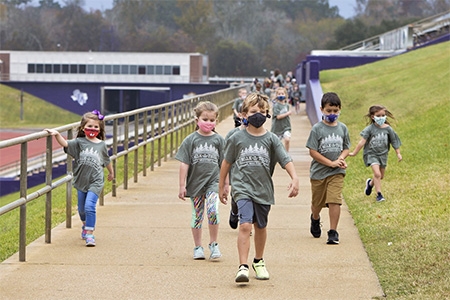
Students at the Stephen F. Austin State University Charter School walked around the concourse at SFA’s Homer Bryce Stadium Nov. 20 for their 12th annual Walkathon, which set a new school record this year. Supporters and businesses, including Nails 2000, TFP Nutrition, Turner Fabrication and West Loop Animal Clinic in Lufkin, donated over $24,000 for playground improvements at the school. Photo by Robin Johnson
November 20, 2020 - When the COVID-19 pandemic moved many college students to online learning, teacher candidates at Stephen F. Austin State University were among them.
Those in SFA’s Community Responsiveness and Engaged Advocacy in Teacher Education program, or C.R.E.A.T.E., saw their usual face-to-face community engagement projects canceled, but they soon found service-learning opportunities through a new partnership formed between C.R.E.A.T.E. and the North Carolina Museum of Natural Sciences at Whiteville.
“Community engagement and service are hallmark experiences of the C.R.E.A.T.E. program, and I did not want students to miss out on this type of authentic learning just because most would not be residing in Nacogdoches during the fall 2020 semester,” said Dr. Lauren Burrow, associate professor of education studies and cofounder of C.R.E.A.T.E.
Dr. Shelby Gull Laird, former assistant professor of forestry at SFA and head of the Whiteville branch of the museum, saw a way to help provide online service-learning projects for SFA teacher candidates and connected Burrow with Brian Wuertz, community engagement educator at the museum.
“I knew this partnership could help SFA teacher candidates develop their teaching and activity creation skills even though they’re working online,” Laird said.
To help the four student teams design family-friendly activities for museum visitors, Wuertz guided them in applying the knowledge and skills they gained through Burrow’s writing methods course and the science education course taught by Dr. Tonya Jeffery, assistant professor of education studies.
“The teacher candidates synthesized our needs with their teacher training to create resources that will engage guests in exploration and inquiry in underutilized outdoor spaces at our museum,” Wuertz said. “In addition to generating curiosity about science and nature, these resources will help promote literacy skills.”
The resources, including activities and books, will become property of the museum.
The teacher candidates said they will apply what they’ve learned during this opportunity in their own communities.
“We learned a lot about community partnerships and how we can work with different organizations in our school districts to design experiences for children that will complement what they’ll learn in the classroom,” said Destinee Davis, an elementary education senior from Tyler. “This experience has been a real eye-opener for me.”
Davis said this lesson prompted her to focus on details like copyrights as well as the big picture of how students from a different state would respond to the material she created for use outside a classroom setting.
“There aren’t many education seniors who can say they’ve collaborated with a museum before,” Davis said. “This project is something I can be proud of, and when it's time for those future job interviews, I will definitely make sure to mention my experience collaborating with an out-of-state museum to help with student learning.”
For more information on C.R.E.A.T.E., email Burrow at burrowle@sfasu.edu or Dr. Heather Olson Beal, professor of education studies and cofounder of C.R.E.A.T.E, at olsonbehk@sfasu.edu. For more information on the museum, visit naturalsciences.org/visit/whiteville.




